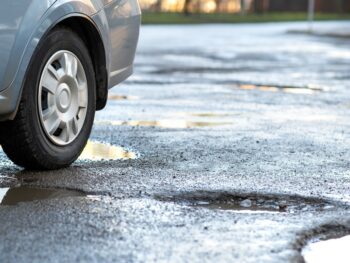Pothole breakdowns up a fifth in 12 months, RAC reports
Vehicle breakdowns caused by potholes soared by nearly a fifth in the last 12 months, the RAC has reported.

Pothole breakdown callouts to the RAC have surged nearly a fifth in the last 12 months
RAC patrols attended 9,439 pothole-related breakdowns in the first three months of 2025. That’s up by 19%, or 1,535 RAC rescues, compared to the same period in 2024.
The figure is also more than double the number of RAC pothole breakdown callouts between October and December last year, new data from the firm’s Pothole Index show.
The number of pothole breakdown in the first quarter of 2025 (9,439) equates to 1.5% of all RAC breakdowns – a significant jump on the fourth quarter of 2024 (0.8%) and the first three months of 2024 (1.1%).
The RAC said the rise in callouts for damaged shock absorbers, broken suspension springs or distorted wheels – the breakdowns most likely to be caused by wear and tear from poor road surfaces – was a clear reflection of the true state of the UK’s roads.
“It sadly shows the pothole plague is as prevalent as ever,” stated RAC head of policy Simon Williams.
RAC data also reveals that drivers whose cars have suffered damage as a result of poor roads will have to pay an average of £460 for anything more serious than a puncture.
Government data analysed by the RAC reveals many of England’s roads are in a dire state, with a fifth (19%) of councils having more than 10% of their minor roads in ‘red’ or ‘poor’ condition, meaning further investigation is required to ascertain if immediate work is needed.
Derbyshire has the most major and minor roads in ‘red’ or ‘poor’ condition, with 38%. The London boroughs of Merton and Havering have 34% and 26% respectively, with Nottingham in fourth spot with 21%.
Derbyshire was also top for having the most major roads in ‘red’ condition with 28%. Nottingham has the second most (19%), closely followed by Brighton and Hove (18%).
RAC’s Simon Williams remarked: “While we know the Government has just given a record amount of funding to English councils to sort out their roads, the latest Department for Transport data shows there’s plenty this money needs to be spent on, as a fifth of councils have more than 10% of their minor road networks in ‘red’ or ‘poor’ condition.
“After filling dangerous potholes as permanently as possible, we urge councils to prioritise preventative maintenance such as surface dressing to stop future potholes appearing. Government data shows there’s been a big decline in the amount of this work taking place compared to five years ago, perhaps explaining why drivers’ number one concern in the RAC Report on Motoring is the poor state of the nation’s roads.”
Autoglass has also warned that the pothole damage doesn’t stop at tyres and suspension, and said that the sudden jolts caused by poor road surfaces can cause windscreen damage or worsen existing chips or cracks.
Ed Colley, head of brand and marketing, went on: “We’d encourage motorists to check their windscreens regularly and act quickly if they spot a chip in the glass. Early repair is quick, inexpensive and helps avoid a full windscreen replacement later down the line. If you do have to replace your windscreen and your car has any driver assistance technology, such as a collision detection system, then it is essential an expert recalibrates any cameras fitted behind the rear-view mirror after a replacement to ensure the technology can remain accurate and operate as intended.
“Drivers can’t control the condition of UK roads, but with simple, proactive steps, they can protect their vehicles, avoid costly repairs and stay safer on the road.”
















Leave a comment